The fifth and sixth story in my series on the science fictional media landscape of the future. Fritz Leiber imagines a sinister conjuration of the Girl behind the advertisement and a robot who wanders a post-nuclear landscape selling soda to the charred victims.
Previously: Brian W. Aldiss’ “Panel Game” (December 1955).
Next Up: Tomorrow’s TV (1982). Stories by Isaac Asimov, Jack C. Haldeman II, Ray Bradbury, Robert Bloch, and Ray Nelson.

Tony Roberts’ cover for the 1975 edition of The Secret Songs (1968)
4.5/5 (Very Good)
Fritz Leiber’s “The Girl with the Hungry Eyes” (1949) first appeared in The Girl with the Hungry Eyes, and Other Stories (1949). I read it in his collection The Secret Songs (1968). You can read it online here.
“The Girl with the Hungry Eyes” explores the post-WWII economic boom as television and rapidly growing suburbs expanded the reach and power of advertising. Cold War rhetoric promoted consumerism as a key component of the American Way of Life (source).
A tale of erotic obsession and terror, “The Girl with the Hungry Eyes” imagines a fantastical conjuration of the archetypal advertising Girl selling every conceivable product. Her face appears on billboards across the urban expanse. Her torso or limb holds the object to be marveled at. And her eyes, “the hungriest eyes in the world” (131), tear into the soul and take something away with their gaze. Fritz Leiber’s terrified narrator, the “poor damned photographer” (129) who unleashed her on the world and fell for her spell, confesses “there are vampires and vampires, and not all of them suck blood” (128).
The photographer recounts in hushed and manic tones the story of their fateful meeting. And the “murders, if they were murders” (128) that gripped the city. As if ashamed, he explains the power her eyes held, “they’re looking at you with the hunger that’s all sex and something more than sex” and the faint dizzy feeling he experienced as their interactions increased (131). He plays off his own frailties as the symptom of a larger societal failing—“you know how modern advertising gets everybody’s mind set on the same things” (138). Begging us to agree.
A brilliant formulation of the eroticism of consumerism and the weak men who fall for the charms of the unknown girl who sells the dream. Effective, slick and well-crafted, speculative horror that rattles around your mind like an advertising jingle that just won’t let go.
Highly recommended.
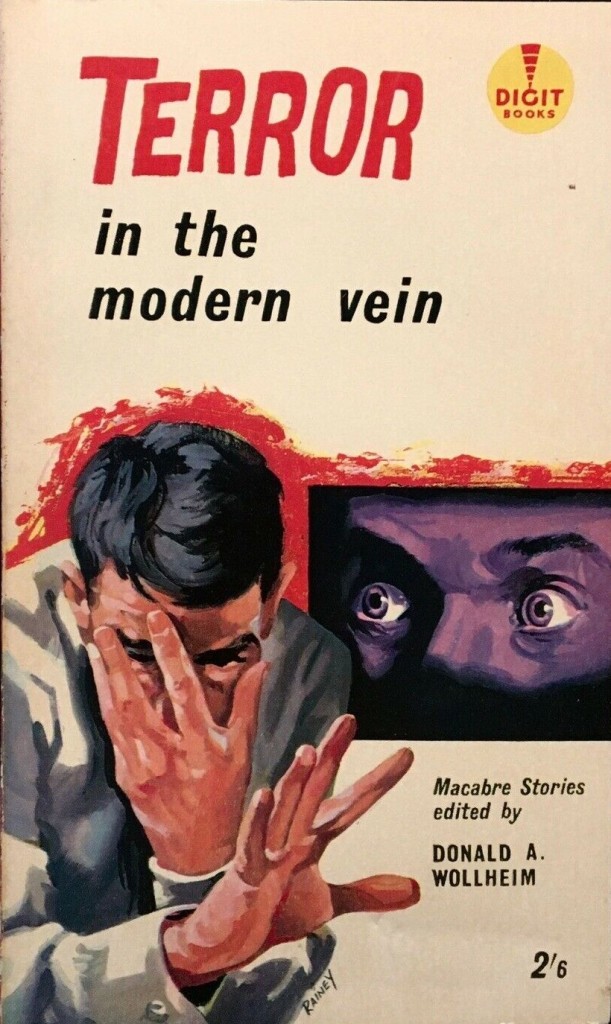
D. Rainey’s cover for the 1961 edition of Terror in the Modern Vein, ed. Donald A. Wollheim (1955)
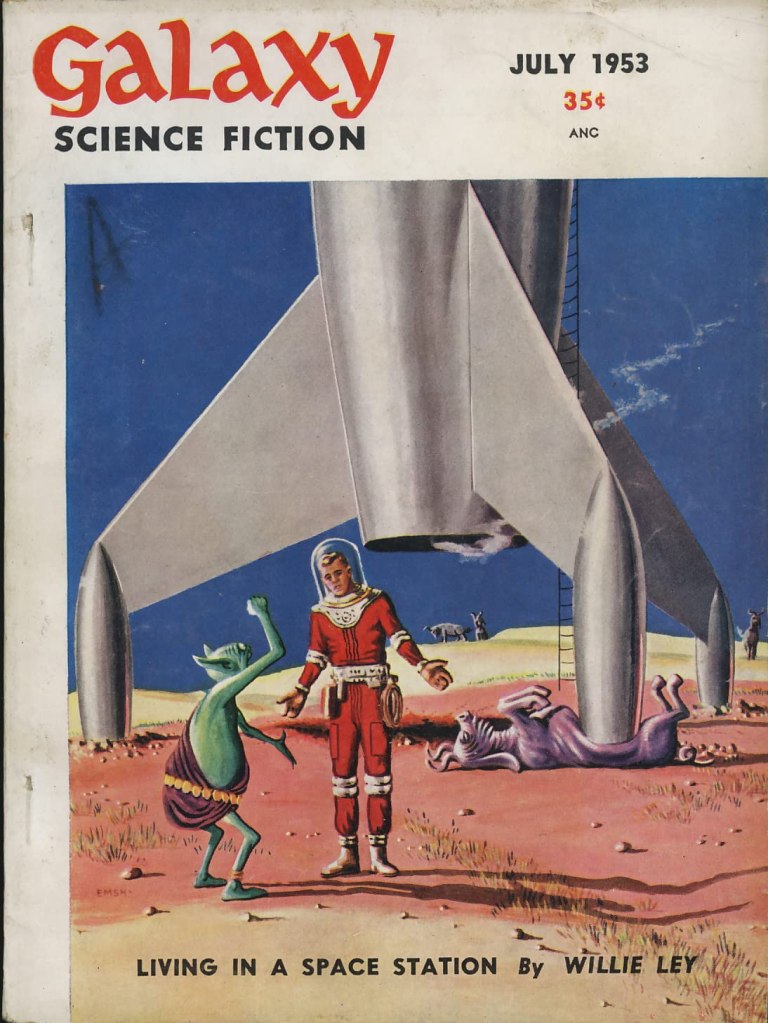
Ed Emshwiller’s cocver for Galaxy Science Fiction, ed. H. L. Gold (July 1953)
4.5/5 (Very Good)
Fritz Leiber’s “A Bad Day for Sales” (1953) first appeared in the Galaxy Science Fiction, ed. H. L. Gold (July 1953). You can read it online here.
“A Bad Day for Sales” pairs a future consumerist media landscape–massive animated billboards and the first automated perambulating robotic vending machines (Robie the Robot) with his pre-recorded advertising soundbites in the voice of a famous actor–with the rapidly disintegrating geopolitical relationship between the US and the USSR. With hilarious (and horrifying) results, Leiber’s deadpan humor collides with a nightmarish danse macabre as nuclear war descends leaving Robie trying to sell his wares to the dead and dying. Demanding money from the victims, the new manifestation of commercial progress trudges on, oblivious to the world around him.
As with “The Girl with the Hungry Eyes,” Leiber explores the disquieting eroticism of consumerism and advertising media. Crowds ogle the “fifty-foot-tall” billboard models dressing and undressing, dressing and undressing (112). Robie’s automated attempts to sell his products–Poppy Pop and comic books—are described in the same terminology as a prostitute turning a “trick” (116). He’s programmed to whistle at attractive women. Women display their bodies in front of his sensors. His prepared advertising soundbites and wares seethe with sensuality–from the “seductivizing Mars Blood” perfume that exudes the “passionate claws” of a Martian sunrise (116) to Gee-Gee Jones, Space Stripper (115), a SF comic book for young girls.
Leiber integrates via headlines that flash on the billboards that line the streets the fracturing geopolitical landscape. The oblivious populous concentrates on the new fangled Robie and his attempts to get kids to buy buy buy. And when death comes, Leiber’s prose terrifies with disengaged/descriptive terror: “The orange flower grew, stem and blossom. The blast came. The winking windows shattered tier by tier, became black holes. The walls bent, rocked, cracked. A stony dandruff flaked from their cornices. The flaming flowers on the sidewalk were all leveled at once” (117). And Robie, unhurt but with sensors askew from the blast, “made some small, uncertain movements, as if feeling for broken bones” (117), before his program sets in again.
I loved this one.
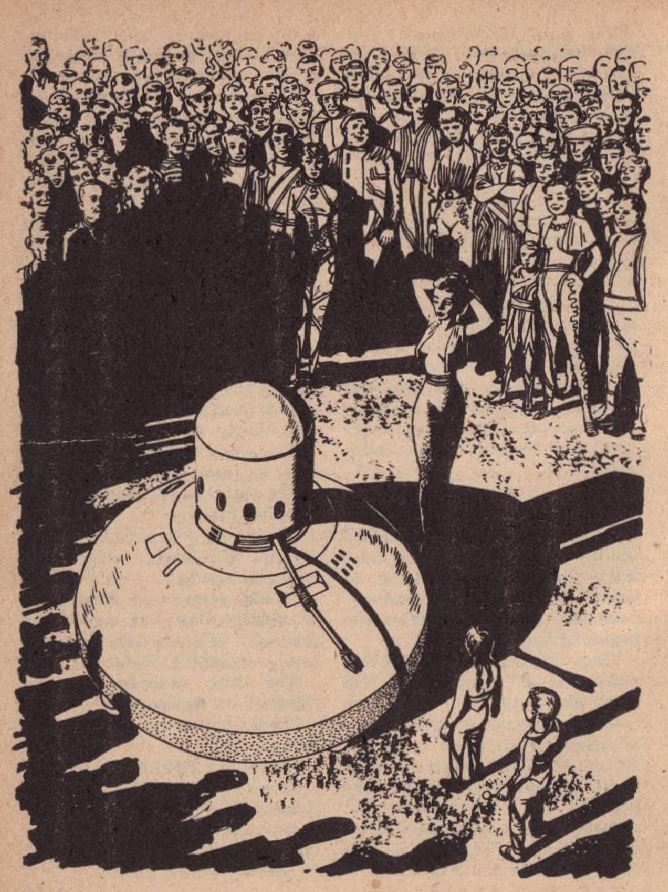
Ed Emshwiller’s interior art for “A Bad Day for Sales” in Galaxy Science Fiction, ed. H. L. Gold (July 1953)
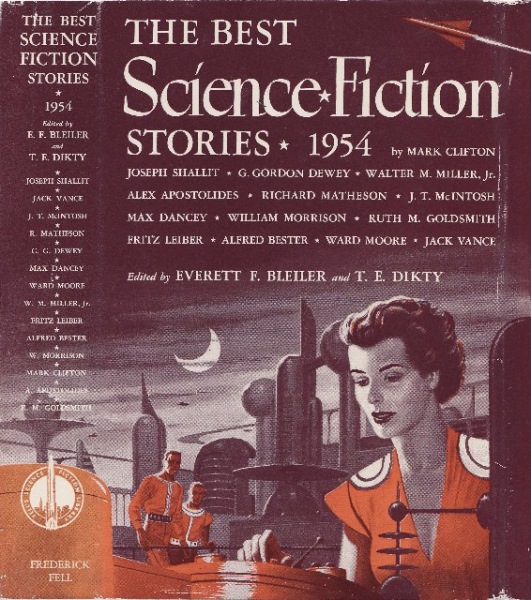
Uncredited cover for The Best Science-Fiction Stories: 1954, ed. Everett F. Bleiler, T. E. Dikty (1954)
For book reviews consult the INDEX
For cover art posts consult the INDEX
For TV and film reviews consult the INDEX
Uncle Fritz saw the inappropriate sexualization of the culture with great clarity. It’s depressing, isn’t it, the way one isn’t allowed to want something without desiring it.
It is depressing — and Leiber’s deadpan delivery combined with great horror emphasize it in the extremes of Indonesian shadow puppets! (not sure why that image jumped to mind).
Did you read both? One? Tempted by either?
But yes, in “The Girl with the Hungry Eyes” the idea of the advertisement as a flesh and blood psychic vampire who murders those who fall for her is simply genius. And the incantation she “chants” at the end, it is blood-curdling. Loved both!
Oh yes, I’ve read both…I think “A Bad Day for Sales” is, frankly, the best story Leiber wrote. It’s a basal story in his literature of disillusionment. And he’s so utterly disillusioned it’s hard to pick out stories where it’s not the soul of his work.
Leiber’s best?! Strong words! That said, I was tempted to give it a 5/5. I did enjoy it more than “The Girl” but I still think that “The Girl” might be a better story…
I apparently gave “A Pail of Air” (1951) and “The Foxholes of Mars” (1952) a 4.5/5, and the highest rated short story I’ve read so far is one of his best known — “Coming Attraction” (1950), which I gave a 4.75/5. All three of those were in A Pail of Air (1964). https://sciencefictionruminations.com/2013/09/23/book-review-a-pail-of-air-fritz-leiber-1964/
I’m not sure what I’d give The Big Time now if I were to reread it… And The Wanderer was just bad… so yeah, these two plus those I mentioned earlier in this comment are definitely the best of his I’ve read so far.
I love both these stories and “Coming Attractions”. I also think “Bazaar of the Bizarre” puts Leiber’s critique of consumerism into sword & sorcery fantasy. When he hits the mark, he hits it hard.
Hello Justin,
Thanks for stopping by. But yes, those three stories make a wonderful trinity of Leiber’s genius. I am intrigued by “Bazaar of the Bizarre” although I’ve never much tolerated his more overtly fantasy visions like the Grey Mouser stories.
Know any other stories that might fit this current reading initiative theme?
I read something a while back in one of the 1960s magazines on Gutenberg Helen Urban’s “The Glory of Ippling” and not as scathing as Leiber, but it’s absurd. It might fit as it’s aliens trying to impress humans with their superiority when the humans have just left a wrestling show.
Helen M. Urban is not an author I know. Hmm… I’ll put it on the list for future exploration. Thanks!
Does it directly engage with issues of media? Even if it doesn’t in an explicit way, I’m always interested in exploring the works of lesser known authors.
It’s media-saturated humans not being impressed by an advanced intergalactic civilization because they’ve seen it all before.
Oh, that sounds perfect. Will put it on my list! Thanks again.
Fritz Leiber truly shines in the short story form.
The last paragraph of ‘The Girl with Hungry Eyes’ is possibly one of my all time favourite paragraphs from any short story, a prose poem in all but name:
‘And this is what she said, “I want you. I want your high spots. I want everything that’s made you happy and everything that’s hurt you bad. I want your first girl. I want that shiny bicycle. I want that licking. I want that pinhole camera. I want Betty’s legs. I want the blue sky filled with stars. I want your mother’s death. I want your blood on the cobblestones. I want Mildred’s mouth. I want the first picture you sold. I want the lights of Chicago. I want the gin. I want Gwen’s hands. I want your wanting me. I want your life. Feed me, baby, feed me.”’
Superb.
I need to reread ‘A Bad Day for Sales’. It’s been a while.
Have you read his novel ‘The Green Millennium’? It’s from 1953. It’s not great, but where it does shine is in the world building that is concentrated mostly in the first chapter, if I recall correctly. Interestingly, it shares some of these world details with the superlative short, ‘Coming Attraction’. I only mention ‘The Green Millennium’ because what hooked me was its vision of an ad filled future, that resonates with the Leiber under discussion.
That final paragraph poem of “The Girl” is even more creepy as earlier in the story he had spilled his entire life to her and observed that she did not appear to have been listening or caring about what she said. But in reality…. she remembered every detail….
Expendable Mudge claimed “A Bad Day for Sales” is his best story! I loved it as a mood piece. A slice of a moment before and a moment after and the sad empty movements of everyone stumbling around. As Expendable said, it’s a “basal story in his literature of disillusionment.” It seeps with aimlessness. It’s secretly so radical in its emptiness. What are we to grasp at?
I have not read The Green Millennium yet. I’ve been far more disappointed with his novels than short stories so far in my exploration of his work. I did enjoy The Big Time but disliked The Wanderer (1964) — easily one of the worst novels ever to win the Hugo.
I read it about 5 or 6 years ago and there were some interesting characters in the future world that was a a projected future of exaggerated traits of the 50’s including sex on one side and conservative puritanism on the other. It is very dated now and I would only recommend it to someone who can put themselves in a 1950’s state of mind. Once they have achieved this 1950’s state they will enjoy following the mysterious green cat in this lightweight romp of the 1950’s on steroids (literally and figuratively).
JB: ‘I’ve been far more disappointed with his novels than short stories so far in my exploration of his work.’
You might try Leiber’s THE SILVER EGGHEADS, from 1962. It’s been decades since I’ve read it, but I recall it as slight but okay, with a rushed pro forma ending — it was an expansion of a novelette in F&SF. Come to think of it, it might fit in your media series, as its main notional motif is the idea that in the future big, two-storey UNIVAC-type computers (it was 1962) write all the fiction and the writers only play at being writers, till there’s some kind of breakdown or strike and they actually have to write. Like that.
I’ll post the Emsh F&SFcover here, because it’s fine; 1962 was a high-point for Emshwiller (he quit and moved on to avant-garde video a few years later).
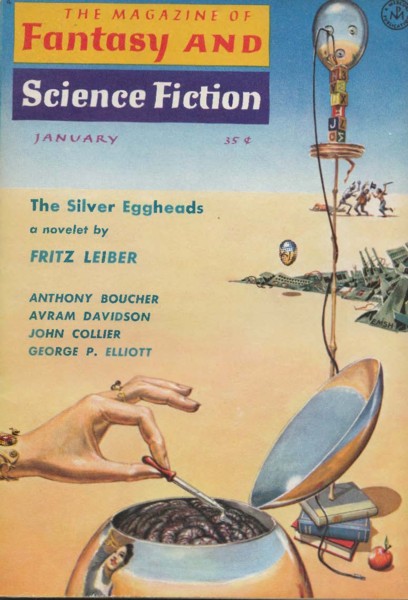
All of Leiber’s novel-length SF works strike me as at best only interesting and quirky — maybe excepting THE BIG TIME, which is very short — because he doesn’t seem to really mine consistently any deep science-fictional-type idea through any of them. His pure fantasy novels like CONJURE WIFE, YOU’RE ALL ALONE, and OUR LADY OF DARKNESS, and his fantasy novels in SF drag like GATHER, DARKNESS! work a lot better, on the other hand. I would claim that’s because Leiber was in fact a fantasy writer — a formative, consequential one, with CONJURE WIFE — who also wrote SF after his fashion because the SF genre was the more commercially significant market in his day.
At the short length, conversely, Leiber as SF writer was significant.
Algis Budrys, in his role as critic, singled out the stories ‘Coming Attraction’ (1950) and ‘Smoke Ghost’ (1941) as having both been enormously innovative and important for going ahead to where the SF field, in the case of the first story, and fantasy, in the case of the second — because it introduces a whole new idea of industrial, urban fantasy — would go. And using my historical imagination, I can just about see why if you were reading back when those stories first came out, Budrys made those claims for them.
As for these two stories, I’ve read them but so long ago I can’t recall a thing about them. I might look at ‘Girl with the Hungry Eyes’ again — it sounds like it takes the same tack as ‘Smoke Ghost- — and if anything occurs to me about them I’ll get back to you.
P.S. The uncredited cover for the 1954 Bleiler-Dikty is almost certainly early Emsh by the looks of it.
Hello Mark,
I went ahead and bought a copy of The Silver Eggheads (1962) — count me intrigued. Can’t promise when I’ll get to it.
“The uncredited cover for the 1954 Bleiler-Dikty is almost certainly early Emsh by the looks of it.” — unfortunately, other than volume 1, no artists are credited: http://www.isfdb.org/cgi-bin/pe.cgi?9121. But yes, the female figure especially looks like the archetypal Emsh woman. Unfortunately, I go by what isfdb.org says and as of now there’s no definitive proof one way or the other. If you have some, let me know! I know who to contact to get the entries changed.
I’ve read and enjoyed “Coming Attraction” (1950) but haven’t read “Smoke Ghost” (1941) yet. After these two stories I’m reinterested in tracking down more of his short fiction.
If you pick “The Girl with the Hungry Eyes” up again, let me know what you think!
Now wishing someone would do a Collected Leiber the way they did for Sturgeon a few years ago. Probably could skip the Lankhmar stories but it would be interesting to see a complete collection and trace the arc of his work.
I’m with you there. The short fiction I’ve read of his so far has been solid to brilliant. While no fan of the Lankhmar stories myself, I understand their historical merit and importance for the genre.
What are you favorite Leiber tales? Have you read either of these?
I have a higher opinion of Fafhrd and the Grey Mouser than you but I do appreciate his more satirical, sharply observed work. The two you reviewed are favorites along with Gonna Roll the Bones
The closest I’ve found is The Leiber Chronicles: Fifty Years Of Fritz Leiber.
‘The Girl with Hungry Eyes’ is a great story. I think that Leiber was on the leading edge with this comment American advertising and consumerism when he wrote this in 1949. This story also brought to mind another of my favorites – ‘Shambleau’ by C. L. Moore. My favorite Leiber story was ‘Gonna Roll the Bones’.
Thanks for stopping by and leaving a comment. I haven’t read “Gonna Roll the Bones” yet but I frequently see it proclaimed as one of his best. If you know of any other media-themed short stories from this era, let me know. I’ve compiled a lengthy list (with tons of assistance from readers) and hope to get to them soon as my Spring Break looms…
I also agree that “Gonna roll the Bones” was my favorite Leiber short story with “The Girl with Hungry Eyes” 2nd and “The Moon is Green” 3rd. Leiber covered a wide range in his stories from SF to fantasy to sword and sorcery and did them all well most of the time although I’ve come across a few clunkers. I really enjoyed “The Big Time” but didn’t like any of the other Time War related stories very much.
I was born in 1947 so for some reason “The Girl with Hungry Eyes” made me think of the Judy Holliday movie It should Happen to You but shifted to the far reaches of The Twilight Zone or The Outer Limits.
Two of my favorites! Indeed, I can’t fully remember “Girl”, it’s been about twenty years, but I can remember big chunks of “Bad Day For Sales” verbatim, it manages to be both funny and horrifying at the same time.
Hello Tom,
Thanks for stopping by! Yeah, both are great stories. I also recommend “The Moon is Green” (1952) from that same era if you haven’t read it yet! — https://sciencefictionruminations.com/2022/12/29/short-story-reviews-fritz-leibers-the-moon-is-green-1952-and-sonya-dormans-go-go-go-said-the-bird-1967/
I include a link to the story in the review.